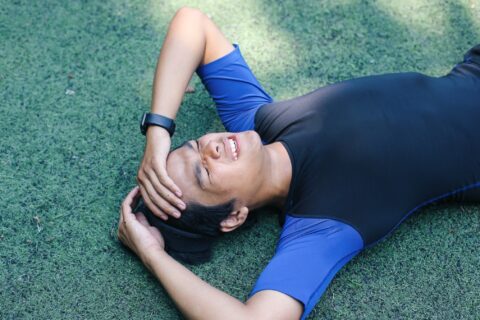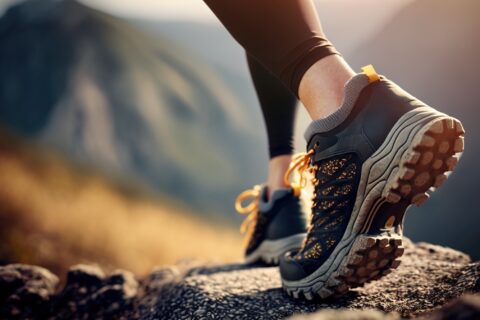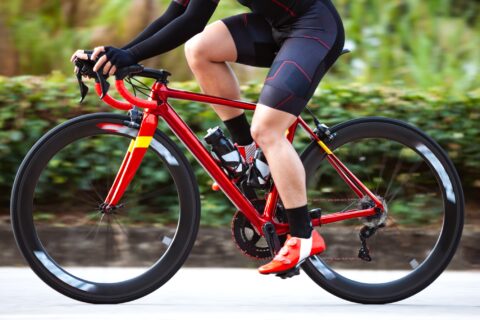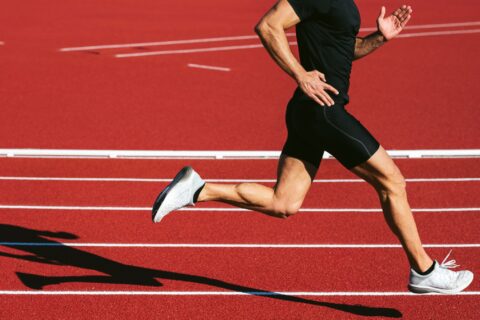Saddle sores, numbness, and erectile dysfunction are just a few of the issues that can hamper male cyclists. Dr. Andy Pruitt details how to avoid these and other cycling saddle problems.
Video Transcript
Intro 00:09
Welcome to Fast Talk Laboratories, your source for the science of endurance performance.
Chris Case 00:20
Hey, everyone, I’m Chris Case, joined today by Dr. Andy Pruitt, the director of Sports Medicine here at Fast Talk Laboratories. Today we want to talk about what you like to call saddle diseases. Let’s start with the most common one, saddle sores.
Picking the Right Saddle
Dr. Andy Pruitt 00:34
Well, before we get into the pathologies or diseases, let’s talk about, let people know how maybe they should shop for a saddle. How do you pick the right saddle? What’s the right saddle for you? I mean, one of my favorite little sayings is, the right saddle in the wrong place is as bad as the wrong saddle. So, you know, fit plays a role here, but that’s not why we’re here today, right?
Chris Case 00:55
Right.
Dr. Andy Pruitt 00:56
So, fit plays a huge role, and I would say that the saddle is the center of the fit universe. So, anybody out there who buys a new saddle, especially a new saddle design, must consider the overall fit of their position on the bicycle. So, we’ll get that out of the way. It’s not why we’re here today, but it is a huge, huge piece of saddle pathology.
What To Consider
Dr. Andy Pruitt 01:19
So, there are two things to consider when you’re picking a saddle. One is your experience, what are you going to do with it? So, there’s gravel riding now, there’s road riding, there’s mountain bike riding, there’s all-terrain stuff, there’s all-mountain, and they all have a different experience and the time you spend on the saddle and your body’s position hovering over that saddle and on that’ll change with each experience, right? So, we’ve got to think about what the experience is, how much padding might you need? How much padding don’t you need? Padding is something we need to talk about, it’s not all it’s cracked up to be. The other thing is you the human, and if we could strip everybody down, and we had some magic technology where we could just look at them and see only their pelvis, right? Only their posture.
Chris Case 02:04
Like this one right here.
Dr. Andy Pruitt 02:05
This guy right here, just has you laying on the table.
Chris Case 02:07
Yeah.
Dr. Andy Pruitt 02:08
We would see, first, the width of these guys called the ischial tuberosity, known in the cycling world as the sit bones. What we’re doing is obviously we’re sitting on them on the saddle, the only time we sit on the sit bones is in a cruiser position, riding with no hands celebrating the victory, you’re really only here momentarily. Most of the time we sit on the pubic rami, which is this more forward aspect of the ischial tuberosities, ischial tuberosity sit bone, this ramp it’s called the pubic rami, and somewhere in here is where we typically sit. So, in the store, depending on the brand, depending on the store itself, how into fit they are, they’ll have apparatus to help you measure this distance, right? So, that distance is the starting conversation on picking a set, regardless of experiences, experiences aside for a second. So, just picking the width of the saddle.
Chris Case 03:09
And by width of the saddle, what do you mean? I don’t know if I’m jumping ahead there.
Saddle Width
Dr. Andy Pruitt 03:15
Jump away. It’s a great question. So, saddles are measured outside to outside. So, the very farthest edge to the farthest edge, but the available seating area varies by the shape of the saddle. So, this is the rather domed, semi-dome saddle. So, the available seating area is lessened by this slope. So, the flatter the saddle, the greater the available seating area, the more room you have to kind of move around on it to share stresses of the tissues, the more dome saddle kind of locks you in, it’s Tour de France time, so everybody’s watching the tour and watching these guys all forward flexed way over this, they’re sitting very far forward on the pubic remi. On a curved saddle, it’ll let it kind of mold itself right in there and you stay in one place. The more shape the saddle has the more locked into place you’re going to be, that can be good for performance, but it can be bad for tissues, right? One of the first things we’re going to talk about is saddle sores, and one of the most common ways we get a saddle sore is a thing called ischemia, right? So, if I take my little pink palm, and I press on it and make a white spot, that’s ischemia. I pressed the blood out of these capillaries in this tissue, and if you do that long enough, it’ll begin to ache. The tissue is starving for the blood supply that has not been allowed in there.
Chris Case 04:44
Right.
Dr. Andy Pruitt 04:44
So, if you sit in one place for a really long time, that tissue is going to become ischemia. There are lots of results of ischemia, it can be bruising, it can be thickening and scarring, it can be a pressure sore, which becomes a saddle sore. So, under saddle sore, there can be pressure sore, bruise, pimple, folliculitis, you know, an infected hair follicle, all these things, sometimes there is a hard little ball that just needs time to let that tissue relax and breathe, and sometimes it becomes a pustule, and drains like a boil or like a giant pimple.
Chris Case 05:31
Right.
Dr. Andy Pruitt 05:32
So, worst-case scenario, those ischemic pressure sores, can rupture and need to be addressed by a medical practitioner. Most of us that have been riding enough, have learned how to care for them in the shower, but whatever it is a wound, right?
Saddle Sores
Dr. Andy Pruitt 05:52
It is a wound that needs to be dealt with. So, again, Tour de France time, what do those guys do? 21 days in the saddle, rain, sleet, sweat, all that stuff, find its way into the chamois between you, and your skin, and the chamois, and the saddle. So, you’re on a multi-day tour, you’re doing RAGBRAI right across Iowa, you’re doing right across Oregon, you’re doing any of these things where you’re in the saddle and that tissue is ischemic day after day. So, you’re probably going to get irritation there, right? So, that takes us to how do you deal with a hair follicle? Infected hair follicle? How does the hair follicle get infected? It gets sheared off, right? It gets sheared off at the surface, and so suddenly now you’ve got this little stubble, like a beard stubble, and it will get ground down it can get infectious down in the hair follicle bed itself, and it becomes a pustule, that kind of thing. So, you’ve got ischemic saddle sores, you’ve got hair follicles that can become inflamed, which the back of the Tour de France guy, right? He’s got to deal with this, and he has to get back on his bike the next day, you and I can go, “I gotta saddle sore.”
Chris Case 05:52
Yes.
Chris Case 07:14
Take a day off.
Ischemic Saddle Sores
Dr. Andy Pruitt 07:15
I’m taking the day off. These guys must get back on. So, they will use a variety of different lubricants, right? So, if you walk into the bike shop, you’re going to find a water-soluble chamois cream. I think water-soluble chamois creams are great for the shorter distance. They’re water-soluble, which means they’re going to be swept away and there’ll be drained away. The longer events, the multi-day events, I’m a big fan of petroleum jelly, right? Don’t want to get into brands but Vaseline you can buy medicated that has triple antibiotic ointment in it, you can buy generic Vaseline and buy your own triple antibiotic ointment, joined together one to one, you got your own medicated petroleum jelly. That’s what I really like for the long, multi-day things. Petroleum jelly makes cleansing hygiene harder, you know, the water-soluble stuff went away.
Chris Case 08:17
Yes.
Dr. Andy Pruitt 08:17
By the end of the day, the petroleum jelly stuff is still there, it’s potentially clogging your pores, which you don’t want, and it’s embedded now into your chamois, which makes laundry a bit more important. So, there’s an upside and a downside to both water-soluble and petroleum-based stuff for avoiding friction.
Friction Saddle Sores
Dr. Andy Pruitt 08:42
Friction, Chris, is the third kind of saddle sore where we get where it’s just an abrasion. Most of us don’t sit comfortably in one spot, we tend to move around, you might have a functional leg length inequality, you might sit rotated slightly, so there’s going to be moved between you and the saddle.
Chris Case 09:03
Always.
Dr. Andy Pruitt 09:04
And the sub tissues and the skin are caught in the middle as well as there. So, the friction can be an abrasion just no different than if you’d skinned your elbow on the carpet or, or whatever it can be abrasion and must be treated just like that. So, hair follicles, ischemic wounds that become open, and abrasions, all our wounds and need to be treated as such. So, you know the perineum, crotch area, is kind of a cesspool or a petri dish of bacteria. So, when you’ve got this open wound, you got to be aware of the potential for infection. So, hygiene, oh my goodness hygiene is crucial. How many times you’ve been on a long ride and it’s a multi-day event, maybe some guys are camping,
Chris Case 09:58
Right, right. Yeah, this is when it gets really challenging.
Dr. Andy Pruitt 10:01
It gets really challenging, and they’re in their chamois in the dinner line.
Chris Case 10:07
Yeah. You don’t like to see that; you don’t want to be that person.
Dr. Andy Pruitt 10:12
You can see it growing. You want to tap them on the shoulder, hey, pal, you know, it’d be right. Yeah. You don’t want to see them in the same short the next day, so never would I never encourage, although you’re getting ready to leave on this long tour, so how we’re going to accomplish laundry?
Chris Case 10:31
Yeah.
Dr. Andy Pruitt 10:31
Those things there.
Chris Case 10:32
It’s a challenge.
Dr. Andy Pruitt 10:33
It is a challenge. I was doing a consulting gig for a company, I won’t mention the brand, but they had a new chamois that was so good at moving fluids and debris through it. They had a guy and a gal do a long tour, I think it was, anyway, they wore the same chamois for 30 days.
Chris Case 10:55
Nice.
Dr. Andy Pruitt 10:56
And neither one of them had a saddle sore.
Chris Case 10:58
Wow.
Dr. Andy Pruitt 10:59
So, I think that they were also very conscious of their hygiene, their grooming, and all those other things, but they didn’t wash it, which is scary. But anyway, clean chamois.
Chris Case 11:12
Clean bodies.
Dr. Andy Pruitt 11:14
I really like an alcohol-based astringent. When I was a kid I remember using Seabreeze for acne, it’s an alcohol-based kind of thing, and so something like, an astringent of some kind get out of your chamois as soon as you’re off your bike, clean yourself with an astringent, soap and water in the shower or bath, and there you have it.
Chris Case 11:37
This brings up an interesting question in my mind, which has to do with grooming. Not unlike the shearing that you spoke about earlier.
Grooming and Hygiene
Dr. Andy Pruitt 11:47
So, grooming and hygiene are critical in caring for the perineum, the crotch area of cyclists. So, we’ve talked about hygiene, so grooming, you know, natural, right? I mean, so hair in the perineum is there for protection, right? So, it’s a leftover from our prehistoric days obviously, but hair is to protect our face, to protect our genitalia, to protect our, that’s,
Chris Case 12:18
the older has a purpose.
Dr. Andy Pruitt 12:19
The older has a purpose, the more I have accepted the wrong right place, but does serve a purpose. So, it’s like little ball bearings, so it actually reduces friction, hair actually reduces friction.
Chris Case 12:32
The hair itself and the oils that it produces act as a bit of a lubricant? Or is it mostly just the hair itself?
Dr. Andy Pruitt 12:37
I think the body oil in its early stage, early in the ride, is a lubricant.
Chris Case 12:42
Sure.
Dr. Andy Pruitt 12:43
When that body oil gets grimy and starts to embed into a pore or a hair follicle bed then it turns into a problem. So, grooming, manscaping is getting to be more and more popular, where less hair seems to be a thing for some people. The men are waxing, men are shaving, men are in the area, but I would encourage cyclists to let it go and be all-natural and you have less of a chance of one of those stubble hairs becoming, you know, some races have beard bumps, any race can get it but it’s much more in the darker-skinned races they get their facial hair is curly as is pubic hair, and you get a little beard bump, they get beard bumps when they shave too much.
Chris Case 13:33
Sure.
Dr. Andy Pruitt 13:33
So, the same thing can happen downstairs, right? Then you’re sitting on these beard bumps and rubbing on them, and so I think hygiene, leave grooming to after the season, maybe? whatever works for you, if your a bathing suit model you might have to do something else but all-natural, I think is the best way to go, and good hygiene on top of that is a really safe way to keep the perineum safe.
Chris Case 14:03
All right, very good. Why don’t we turn our attention now to some of the things that males specifically deal with when it comes to that body saddle interface?
Males and the Body Saddle Interface
Dr. Andy Pruitt 14:12
Yeah, so I think that anybody who has ridden a bike before 1975, we all thought numb genitalia, painful urination, were part of the sport right? It was pure saddle design at the time, and I would speculate that 80% of everybody’s saddles were to narrow the time.
Chris Case 14:38
Okay.
Dr. Andy Pruitt 14:38
Especially the racer dude, right? As things have progressed, saddle design has progressed. So, painful urination after a multi-day long ride, you bruised the urethra, the tube that goes in your bladder that acts as the penis, that might be something you would experience in a multi-day adventure, especially the rough terrain, but most of the time, that should not be tolerated, right? That painful, burning urination, that is a sign that something is wrong with your bike position.
Chris Case 15:18
Don’t ignore it.
Dr. Andy Pruitt 15:18
Don’t ignore it. Happens one time. Okay, but don’t ignore that. It is meaningful that you’ve got the wrong saddle or the right saddle in the wrong place. The wrong stem, something is putting pressure in that area. So, if we think about the way we sit, we got the ischial tuberosities, this area is called alcock canal, and all the goodies live in alcock canal. So, think about this, right? That it’s just like a wedge or a log splitter, if you will, so everybody’s tissue, all-male tissues are different, so sometimes the nerve called the pudendal nerve, which is the numbness, the urethra and the arteries flow through alcock canal, and in some of us it’s really well protected in tissues, fats, and cornified thickened skin, and it’s really well protected, and those guys can almost ride anything. The low body fat guy, maybe his structures have been placed genetically a little closer to the skin, he’s a little more fragile. So, saddle choice and position are gonna be crucial to protecting that thing. So, painful urination, urethritis, if you will, inflammation of the urethra should be fleeting, if you have it, if it’s not fleeting deal with it.
Dr. Andy Pruitt 16:45
1970, I think it was 1979, the editor of Bicycling Magazine was an ultra-endurance rider, and he discovered that he had erectile dysfunction, and it was linked directly to his time on the bike, the position, and his saddle choice. Erectile dysfunction in male cyclists was far more epidemic than we knew at the time, he opened the lid of discussions, and from that has come much more medical study on it, way better saddle designs across the entire industry. A guy named Roger Mancala really developed the original cutout, if you will, his original style was called the Mancala wedge, and it basically was to ensure that we were sitting on bony structures and using the hole in the saddle and support on the bony structures to give this fragile area relief. So, erectile dysfunction I think that if you did a survey, I know if he did a survey of riders who rode before that time, 50% would tell you that they experienced at least numb genitalia, transient erectile dysfunction, or urethritis at some point in their career. A good friend of mine is doing a study, retrospective study, and if you went to see a urologist over 40 or 50 right now, he might tell you to stop riding your bike. The younger urologist has figured out that it’s really about position, saddle choice, and that erectile dysfunction can be avoided, right? So, I think science between medicine and industrial design, we have almost eliminated the epidemic of erectile dysfunction in male cyclists. So, get that right saddle, get it in the right place, that is the key to life to avoid those issues. Okay, so what about a guy my age? I’m 71, I’ve been racing bikes for 40 years, riding bikes 60 years, right?
Chris Case 19:27
Yeah.
Dr. Andy Pruitt 19:28
So, I probably have some vascular scarring from all those bad positions and all those I want to look like Bernardino positions, right? For our younger listeners, we already know, he was a great guy back in the day, right? I probably have some vascular scarring that leads to, if bad enough, can lead to erectile dysfunction, even with a better position, better saddles, and those kinds of things.
Chris Case 20:04
The only solution for reversing that would be to stop riding or do you think that stuff is permanent?
Dr. Andy Pruitt 20:11
The vascular scarring is perineum but we have ways medically to get around that, right? So, you live a normal life, but it is permanent it’s no different than heart disease, right? The scarring that occurs, sclerosis that occurs in any artery,
Chris Case 20:29
Sure.
Dr. Andy Pruitt 20:32
So yeah, transient, I think the last thing you probably want to talk about is this transient. numbness. Let’s say you’re a perfect biomechanical 10, you got a perfect bike position, you’re riding a full-suspension mountain bike, you got lots of squish, right?
Chris Case 20:51
Yeah.
Dr. Andy Pruitt 20:51
And you go on a really technical mountain bike ride, and full suspension bikes can come back to get you every now and again, they can buck up into you as that rear suspension returns to neutral. So, every now and then, you can get just a little quick bop,
Chris Case 21:08
Yes, I know what you are talking about.
Dr. Andy Pruitt 21:09
Yes, and you can get a little transit, it’s like hitting your funny bone, right? That’s not so funny, but anyway, you hit your funny bone, you get a transient numbness, and it will typically be gone within a few hours after your ride. If not, you have probably suffered a neural contusion and I probably would visit with a urologist If your transient numbness isn’t so transient. So, the bottom line here, get the right saddle, right size saddle, get it in the right place for your particular experience of the day.
Chris Case 21:48
Don’t suffer, there is no reason to suffer anymore.
Dr. Andy Pruitt 21:52
There is no reason to suffer anymore. You should be able to ride your bicycle really want to without suffering, other than physical exertion.
Chris Case 21:59
Yes, you’re right. Very good.
Dr. Andy Pruitt 22:01
Yeah.
Chris Case 22:01
Excellent. All right, so all, if somebody does have an issue like this, what should they do?
How To Solve Male Related Saddle Diseases
Dr. Andy Pruitt 22:09
Well, I think if it’s early on in their process, right? Even if it’s not early on, if it’s chronic, I’m happy to chat with these folks in our sports medicine consultation time, happy to help figure out whether this is a bike fit need, whether it’s a saddle choice, or whether it’s a referral to the local urologist. I think, happy to help and talk, but if this is not a transient thing and you’ve already been suffering, please just go talk to your urologist.
Chris Case 22:38
Right. Great advice.
Chris Case 22:40
Thank you again, Dr. Pruitt, always a pleasure, and thank you again today for joining us at Fast Talk Labs.



